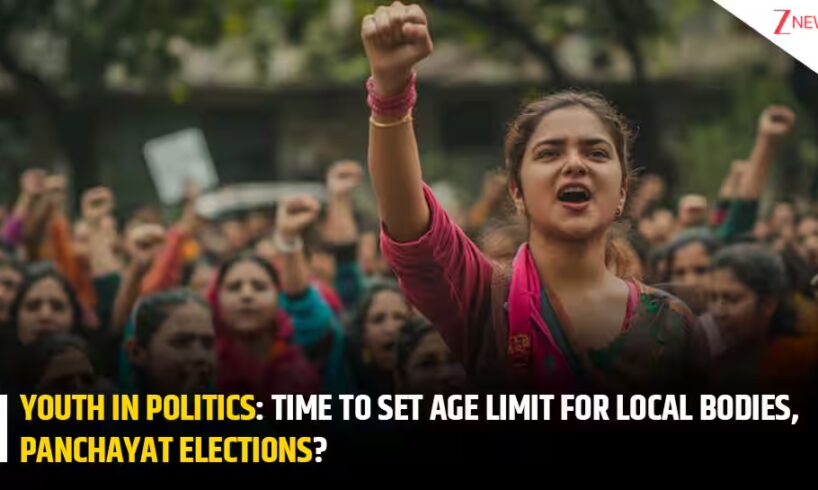
Picture a village meeting where a 23-year-old engineer proposes a solar-powered street-lighting system; a municipal ward where a 27-year-old social entrepreneur pushes for a youth-led waste‑management app; or a panchayat where someone in their early thirties pilots a transparency dashboard for local development funds. These are not distant dreams but realistic possibilities. Yet, political representation at the grassroots continues to rest largely with older, entrenched leadership. Experience matters, of course, but young, educated citizens bring energy, innovation, and a drive for change that local governance urgently needs. To unlock this potential, India must reconsider age norms in local bodies and proactively create room for younger, qualified leaders.
The time is ripe for serious discussion — should India formalise age-based provisions to encourage youth participation in local body elections, for example, setting age bands such as 21-30 for councillors or panchayat members, and 25-50 for mayors, sarpanchs, or MLAs?
Current Legal Framework
Add Zee News as a Preferred Source
At present, the legal framework appears encouraging on paper. The 73rd and 74th Amendments to the Constitution set the minimum age for contesting panchayat and municipal elections at 21. In theory, this opens the doors of grassroots democracy to fresh talent. In practice, however, the dominance of senior leaders, long-standing political families, and entrenched patronage networks means that very few young people make it onto candidate lists. Local bodies, which should be nurseries of political leadership, are often treated as extensions of older political establishments.
This disconnect is particularly striking against India’s demographic reality. Nearly 65% of India’s population is under 35, yet the average age of local representatives in many states remains above 45. Young Indians are digitally literate, globally exposed, and impatient with outdated governance methods. Issues such as climate adaptation, mobility, start-up ecosystems, skill development, and social welfare delivery demand leaders who understand contemporary challenges. While older representatives bring wisdom and administrative understanding, the pace of modern governance requires a balance of experience and youthful dynamism, not dominance by one.
Why Instituting Age Bands Makes Sense
Introducing structured age bands could help correct this imbalance. A lower age band, such as 21-30 for councillors or panchayat members, would ensure that local institutions consistently tap into the creativity, energy, and technical knowledge of young citizens. An upper age band for senior positions, such as 25-50 for sarpanchs, panchayat presidents or mayors, would encourage leadership that is both mature and forward-looking. Such frameworks are not intended to sideline seasoned leaders but to create a more diverse age profile that reflects community needs. Introducing age brackets could bring multiple benefits:
1. Fresh Ideas and Innovation: Educated youth are often well-versed in new technology, social media, and modern governance techniques. They are likely to propose innovative solutions for local problems, whether in sanitation, digital literacy, climate resilience, or participatory budgeting.
2. Long-Term Political Engagement: By granting young leaders early entry, age bands create a structured pathway for political growth. A 25‑year-old mayor today could, in principle, become a seasoned MLA or MP in due course. This builds continuity and leadership development.
3. Better Representation: Youth constitute a significant portion of India’s population. Allowing them to contest in local bodies ensures that their perspectives on education, employment, environment, and technology are represented in governance. This could make local government more relevant to younger citizens.
4. Accountability and Energy: Younger leaders may be more willing to adopt transparency measures, technology in governance, and citizen-centric reforms. Their energy and enthusiasm often translate into more responsive and accountable public service.
This approach also supports long-term political grooming. When young leaders enter politics early, they gain valuable administrative experience, develop a deeper understanding of their constituencies, and build credibility over time. Grassroots roles become genuine stepping stones to higher office rather than ceremonial positions.
Countries that have experimented with younger leadership, from Nordic nations to newly decentralised African democracies, show that young representatives often excel in digital governance, participatory planning and citizen outreach.
Why Status Quo Is Not Enough
Concerns about inexperience or undue influence on younger candidates are valid. Age alone does not guarantee vision or integrity. Similarly, strict age limits might exclude veteran leaders who command public respect. Any reform must be accompanied by clear rules on transparency, capacity building, and, where feasible, educational qualifications.
However, the need for generational renewal cannot be ignored. Local governance shapes daily life, streetlights, water connections, roads, waste management, and welfare services. These areas need leaders who can respond quickly, innovate effectively, and communicate with a rapidly evolving population. Engaging educated youth deepens democracy by bringing diverse voices into decision-making.
Importantly, entrenched leaders often dominate because they control party networks, campaign finances, and local patronage systems, barriers that younger contenders struggle to overcome without institutional support.
Precedents And Momentum
Some recent developments suggest growing openness to youth entry. In Telangana, the Chief Minister proposed reducing the minimum age to contest assembly polls from 25 to 21. The Rajasthan Pradesh Congress Committee reserved 50% of its local-poll tickets for candidates under 50, signalling a shift toward generational inclusion.
Several municipalities worldwide have successfully incorporated younger leaders. Cities like Helsinki and Bogotá have empowered councillors under 35 who led initiatives in digital transformation, cycling infrastructure, youth safety, and participatory planning, proving that young governance can deliver measurable results.
Political parties, too, must share responsibility by allocating more tickets to younger candidates, strengthening youth wings, and providing training in public administration and local governance. Civil society and academic institutions can support this effort through political literacy programmes, local governance fellowships, and grassroots policy training.
Setting age bands is not about sidelining experience; it is about ensuring balanced, inclusive, and future-ready leadership. If India wants its local bodies to remain responsive to the aspirations of a young nation, enabling more young, educated leaders to step forward is not just desirable, it is essential. A democracy that invests early in young leadership secures not only better governance today but wiser leaders for tomorrow.





